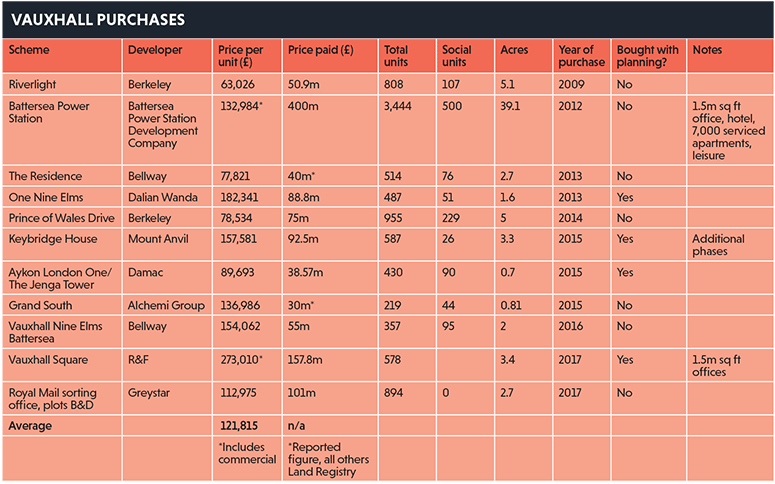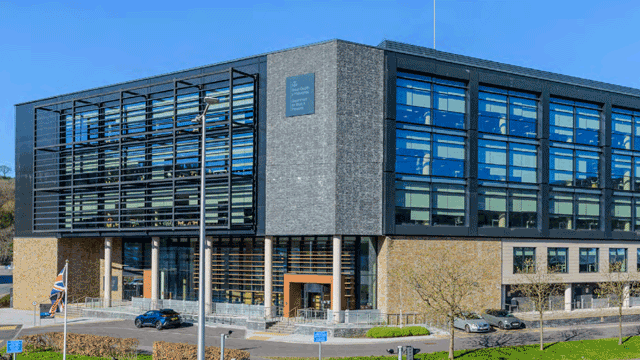Greystar’s acquisition of two plots at the former Royal Mail site in Vauxhall, SW8, this month raised eyebrows across the market, as the rental developer was prepared to spend a sum as large as £101m for undeveloped land in an area widely reported as being in the doldrums.
And that commitment excludes the cost of developing the planned 894 flats.
Taken alongside Chinese developer R&F Properties’ recent £157.8m acquisition of CLS’s Vauxhall Square, the two deals show a level of demand for the area that many thought had dried up since reports of flat flipping, oversupply and London’s cooling prime market began.
But do the acquisitions signal a bargain, or is it that pricing in Vauxhall is holding up?
New research by EG looks into how much developers have paid for major sites in the area, where land prices are available, against the number of flats being developed onsite.
As well as timing and point in the cycle, factors such as the scale of the purchase, the height of the consent and the mix of office and residential affect the prices paid, but basic calculations show the average price paid per unit on development land across the eight years of acquisitions analysed was £121,815. Against this, Greystar paid £112,975 per flat, and R&F £273,010.
What at first seems like a huge discount for Greystar needs to be caveated, as R&F’s buy includes 1.5m sq ft of office space. What also needs to be considered is the types of market to which they are appealing: for Greystar it is PRS, and for CLS the private sale market.
The PRS discount
While Greystar’s purchase price is lower than other recent deals, it is not surprising for a rental developer. Typically, rental operators need to pay about 20% less for land than for-sale developers to make their business model work and cannot compete at the very highest level.
In this case, the Greystar deal could be seen as a bargain by Vauxhall pricing standards and roughly in line with the area of the market at which rental players compete.
However, there has been growing caution around pricing for rental schemes in London, and the rental uplift developers are factoring in.
“The build-to-rent model does seem to be weakening in London… in terms of some of the assumptions going in to it,” says residential analyst Neal Hudson.
“To get it to work [and justify paying high land prices], is why you have seen a lot of BTR schemes going for the premium product and amenities to get rents up. But inevitably, there is always a limit to the demand for these rental products.
“I would imagine if you were taking an open-minded, rational view of your inputs into a financial model, the current market would make it more difficult to come up with those rosy forecasts that make something viable.”
Also important are the rents charged by other buy-to-let investors in the area, which could be looking more for capital uplift, rather than yield-driven returns.
The for-sale market
R&F’s purchase price is above the Vauxhall average, though factoring the office space included in the scheme puts it back closer to the average.
The deal shows confidence in the market, provided there is some diversification away from solely residential product – which is what CLS was hoping for when it altered the scheme’s planning.
“I do think it helps that it is mixed use; it probably de-risked the entire scheme, given that it has a bit of everything,” said CLS chief executive Fredrik Widlund at the time of the deal.
Santhosh Gowda, chief executive of Strawberry Star, says that realistically sales prices of about £1,100 per sq ft are achievable.
“I feel transactions are happening at the right price now,” he says.
“In the short term there is some correction, there is a lot of stock and the secondary market is a bit slower. But there are still transactions happening at the right prices.”
“I think the underlying issue is there is no longer any land available down there – bar what is left at the Post Office site [capacity for 976 more flats], so we are into a period when land supply is the issue,” says James Cobb, residential land and development director at JLL.
“That has certainly bolstered interest, because it’s not a piecemeal regen with other opportunities, that’s 500 acres gone.”
The market in general
Bargain or not, the research shows the two heftiest deals in the area have been made by Chinese investors – with Dalian Wanda paying £182,000 per flat at One Nine Elms, the next-highest spot after R&F.
“I think there has been a consistent ebb and flow [in international interest],” says Cobb. “There has been a function of uncertainty – Trump, referendum, elections – against periods of intense interest, but never this armageddon situation reported.
“But there are also a number of brilliant good-news stories around Nine Elms ignored in favour of the story there is too much supply there.
“There has been the leasing at Battersea Power Station where Phase One is up and rolling, the US embassy is rumoured to be officially opening on 4 July, and then you have the Northern Line extension.”
“But if you look at the longer term, there are Apple and others coming up, and pricing will catch up with the other side of the river,” adds Gowda.
Whether you are glass half full or half empty on the Vauxhall market, both deals show interest is still there.
To send feedback, e-mail alex.peace@egi.co.uk or tweet @egalexpeace or @estatesgazette











